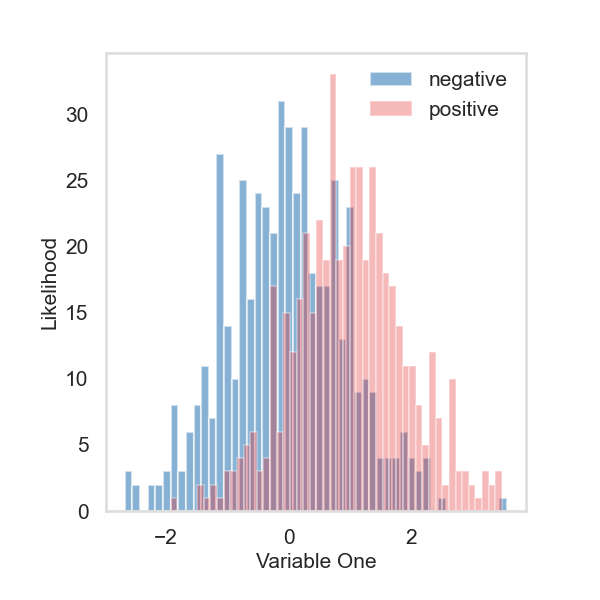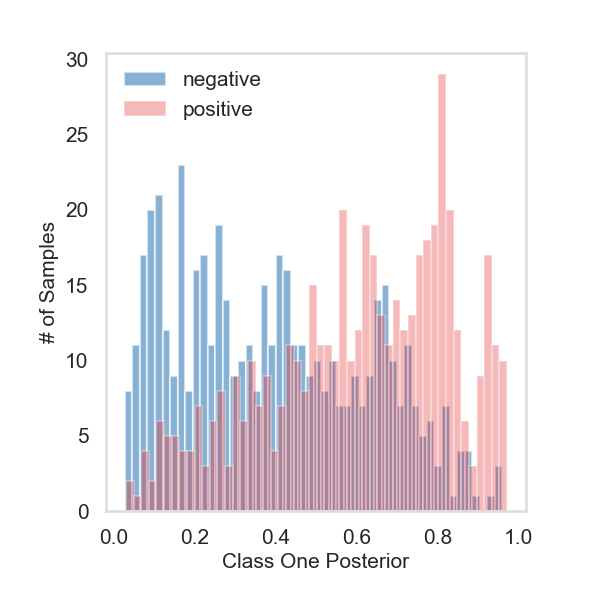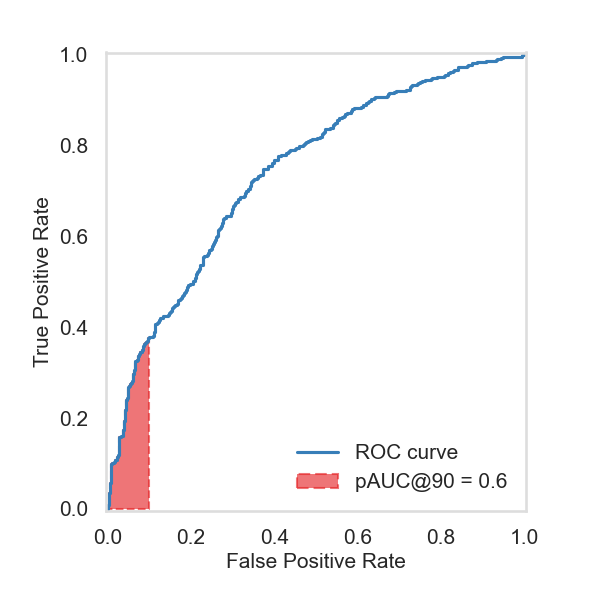Note
Go to the end to download the full example code
Calculating pAUC#
import matplotlib.pyplot as plt
import numpy as np
import seaborn as sns
from sklearn.metrics import roc_auc_score, roc_curve
from sktree.datasets import make_trunk_classification
from sktree.ensemble import HonestForestClassifier
from sktree.stats import build_oob_forest
sns.set(color_codes=True, style="white", context="talk", font_scale=1.5)
PALETTE = sns.color_palette("Set1")
sns.set_palette(PALETTE[1:5] + PALETTE[6:], n_colors=9)
sns.set_style("white", {"axes.edgecolor": "#dddddd"})
pAUC@r#
Partial area under the ROC curve (pAUC) integrates the true positive rates (TPR) when the false positive rates (FPR) are below a specific percentage threshold. Then the value is normalized by that percentage.
\[pAUC@r = \frac{100}{100 - r} \int_{T_r}^\infty \int_{\mathcal{X}} \mathbb{I}\{\eta(X_1) > \eta(X_0) \} dF_1 dF_0\]
With a binary class simulation as an example, this tutorial will show
how to use treeple to calculate the statistic with 90% specificity
threshold.
Create a simulation with two gaussians#
# create a binary class simulation with two gaussians
# 500 samples for each class, class zero is standard
# gaussian, and class one has a mean at one
X, y = make_trunk_classification(
n_samples=1000,
n_dim=1,
mu_0=0,
mu_1=1,
n_informative=1,
seed=1,
)
fig, ax = plt.subplots(figsize=(6, 6))
fig.tight_layout()
ax.tick_params(labelsize=15)
# histogram plot the samples
ax.hist(X[:500], bins=50, alpha=0.6, color=PALETTE[1], label="negative")
ax.hist(X[500:], bins=50, alpha=0.3, color=PALETTE[0], label="positive")
ax.set_xlabel("Variable One", fontsize=15)
ax.set_ylabel("Likelihood", fontsize=15)
plt.legend(frameon=False, fontsize=15)
plt.show()

Fit the model#
# initialize the forest with 100 trees
est = HonestForestClassifier(
n_estimators=100,
max_samples=1.6,
max_features=0.3,
bootstrap=True,
stratify=True,
random_state=1,
)
# fit the model and obtain the tree posteriors
_, observe_proba = build_oob_forest(est, X, y)
# generate forest posteriors for the two classes
observe_proba = np.nanmean(observe_proba, axis=0)
fig, ax = plt.subplots(figsize=(6, 6))
fig.tight_layout()
ax.tick_params(labelsize=15)
# histogram plot the posterior probabilities for class one
ax.hist(observe_proba[:500][:, 1], bins=50, alpha=0.6, color=PALETTE[1], label="negative")
ax.hist(observe_proba[500:][:, 1], bins=50, alpha=0.3, color=PALETTE[0], label="positive")
ax.set_ylabel("# of Samples", fontsize=15)
ax.set_xlabel("Class One Posterior", fontsize=15)
plt.legend(frameon=False, fontsize=15)
plt.show()

Calculate the statistic#
def Calculate_pAUC(y_true, y_pred_proba, max_fpr=0.1) -> float:
# check the shape of true labels
if y_true.squeeze().ndim != 1:
raise ValueError(f"y_true must be 1d, not {y_true.shape}")
# find the positive class and calculate fpr and tpr
if 0 in y_true or -1 in y_true:
fpr, tpr, thresholds = roc_curve(
y_true, y_pred_proba[:, 1], pos_label=1, drop_intermediate=False
)
else:
fpr, tpr, thresholds = roc_curve(
y_true, y_pred_proba[:, 1], pos_label=2, drop_intermediate=False
)
fig, ax = plt.subplots(figsize=(6, 6))
fig.tight_layout()
ax.tick_params(labelsize=15)
ax.set_xlim([-0.005, 1.005])
ax.set_ylim([-0.005, 1.005])
ax.set_xlabel("False Positive Rate", fontsize=15)
ax.set_ylabel("True Positive Rate", fontsize=15)
ax.plot(fpr, tpr, label="ROC curve", color=PALETTE[1])
# Calculate pAUC at the specific threshold
pAUC = roc_auc_score(y_true, y_pred_proba[:, 1], max_fpr=max_fpr)
pos = np.where(fpr == max_fpr)[0][-1]
ax.fill_between(
fpr[:pos],
tpr[:pos],
color=PALETTE[0],
alpha=0.6,
label="pAUC@90 = " + str(round(pAUC, 2)),
linestyle="--",
)
ax.legend(frameon=False, fontsize=15)
return pAUC
pAUC = Calculate_pAUC(y, observe_proba)
print("pAUC@90 =", round(pAUC, 2))

pAUC@90 = 0.6
Total running time of the script: (0 minutes 2.000 seconds)